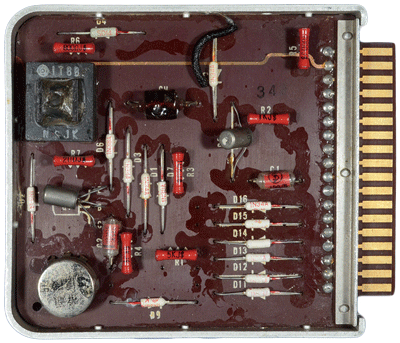

- Home >
- Artifacts of IP Heritage >
- 2015 >
- KDC-I logic package
KDC-I logic package

| Manufactured in | 1960 |
|---|---|
| Manufactured by | Hitachi Ltd. |
| Owner | Kyoto University Archives |
| Location of historical materials | Kyoto University, Academic Center for Computing and Media Studies (ACCMS)
Sakyo-ku, Kyoto 606-8501, Japan |
| Visitor information | Open to the public (Reservation required) |
| Contact | Kyoto University, Academic Center for Computing and Media Studies (ACCMS) https://www.media.kyoto-u.ac.jp/ |
KDC-I is an electronic computer developed jointly by Kyoto University and Hitachi Ltd in 1959. It is based on ETL Mark V and designed mainly by Shuzo Yajima of Kyoto University and Shinichi Iyobe of Hitachi. It is the first transistor computer used in a Japanese university.
KDC-I had a floating-point arithmetic function with a clock of 230KHz. It was equipped with a magnetic drum, a magnetic core memory, and a magnetic tape unit. Its main module started operation at the end of 1959, and all modules including the floating-point arithmetic function was completed in April 1960. The entire KDC-I system including the magnetic tape unit was completed and deployed in the Faculty of Engineering, Kyoto University in July 1960.
Kyoto University founded "electronic computer room", the first computer center in Japanese universities in January 1961, and started its service using the KDC-I in April 1961, which lasted about 15 years. This service for information processing education was highly appreciated and extended by the Educational Center for Information Processing, then by the Center for Information and Multimedia Studies, and now by the Academic Center for Computing and Media Studies. This computer made a landmark of industry-academia collaboration as well as the first deployment of a domestic computer in a national institute.
KDC-I was commercialized by Hitachi by the name of HITAC 102B. This logic package is its main module and should be kept as a Technology Heritage.
